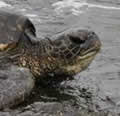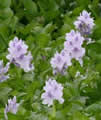2015/03 Hawaii trip - Ka'u south coast |
|||||
 Friday March 6th
Friday March 6th
It was warmer, but raining again as we headed back up the mountain, aiming for Ka’u, the south coast of the island. We stopped first at  another part of the Kilauea park to see more lava trees, actually the collars and pits where the tree trunks used to be.
another part of the Kilauea park to see more lava trees, actually the collars and pits where the tree trunks used to be.
| Lava trees (2.02) |
 |
|---|
Then we were on to the Kipuka Pua’ulu, also known as the Bird Park. Birds there certainly were but most of them were high in the trees and silhouetted against the sky, difficult for us to identify. One exception was this pheasant,  which was too busy with his mating dance to worry about us.
which was too busy with his mating dance to worry about us.
The trees were easier to see, many of them planted in the kipuka to preserve the species, including many koas, much prized for their orange and red wood. There is also a trail from there all the way to the 13000 feet summit of Mauna Loa, maybe a good hike for when I’m twenty years younger.
| Bird Park (2.29) |
 |
|---|
 Ka’u is an empty part of the island, just a few villages and farms surrounded by lava fields and a wild coast of black a’a lava. We drove down to Punalu’u black sand beach, a pleasant spot but busy with tour buses. There were Muscovy ducks in the lagoon and turtles in the sea here.
Ka’u is an empty part of the island, just a few villages and farms surrounded by lava fields and a wild coast of black a’a lava. We drove down to Punalu’u black sand beach, a pleasant spot but busy with tour buses. There were Muscovy ducks in the lagoon and turtles in the sea here.
| Punalu'u Beach (8.51) |
 |
|---|
This turtle was trying to get back into the ocean, but kept losing focus, stopping to nibble at weeds and getting blasted back up the beach by the waves.
Deep in the ocean off this beach another volcano, Lo’ihi, is building, but still a half mile below the surface. It is expected to surface in some tens of thousands of years, to become a ninth island or perhaps to add more land to the island of Hawaii.

We drove further down the coast to South Point Park, the most southerly land in the United States. Sandie wanted to visit the green sand beach at Mahana Bay. Getting to the beach is a bit harder as the road crosses miles of sand, deeply rutted to the point that some parts are now canyons through the dunes, often flooded too. The locals are camped out at the end of the blacktop and are anxious to drive tourists to the beach. Signs exaggerate the distance and warn (falsely) that driving there is kapu for us haoles. We decided to walk, and they told us we’d need a flashlight as we’d never get back before dark.
| Mahana Bay (2.38) |
 |
|---|
 It turned out to be a great walk 2-3 miles along the coast, with black rocks and crashing sapphire-blue waves. In places there were a half
It turned out to be a great walk 2-3 miles along the coast, with black rocks and crashing sapphire-blue waves. In places there were a half dozen parallel tracks so we were mostly well away from the traffic. These cute fruits were growing in the sand, teasel gourds, I think, but they have many other names in Asian countries.
dozen parallel tracks so we were mostly well away from the traffic. These cute fruits were growing in the sand, teasel gourds, I think, but they have many other names in Asian countries.
We found patches of green sand long before the beach, a greyish mixture of lava and coral with olivine crystals  providing the green tint. The climb down the cliff to the beach was difficult, with the trail so deeply embedded in the rock that it was almost a chute. The opposite cliff is a natural art project with its convoluted and eroded layers of lava.
providing the green tint. The climb down the cliff to the beach was difficult, with the trail so deeply embedded in the rock that it was almost a chute. The opposite cliff is a natural art project with its convoluted and eroded layers of lava.  And yes, the sand is green.
And yes, the sand is green.
The walk back was a bit tougher but we made it back to the car without using the headlight. On our way back to the highway we saw a rare sight, a pueo, a Hawaiian owl, by the roadside.
